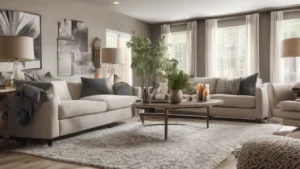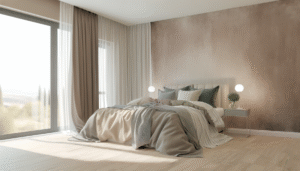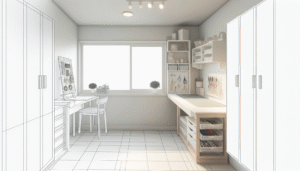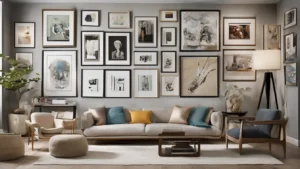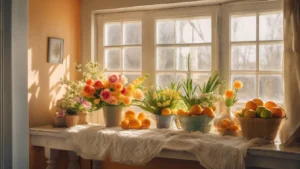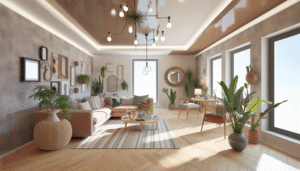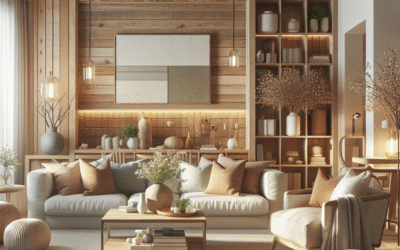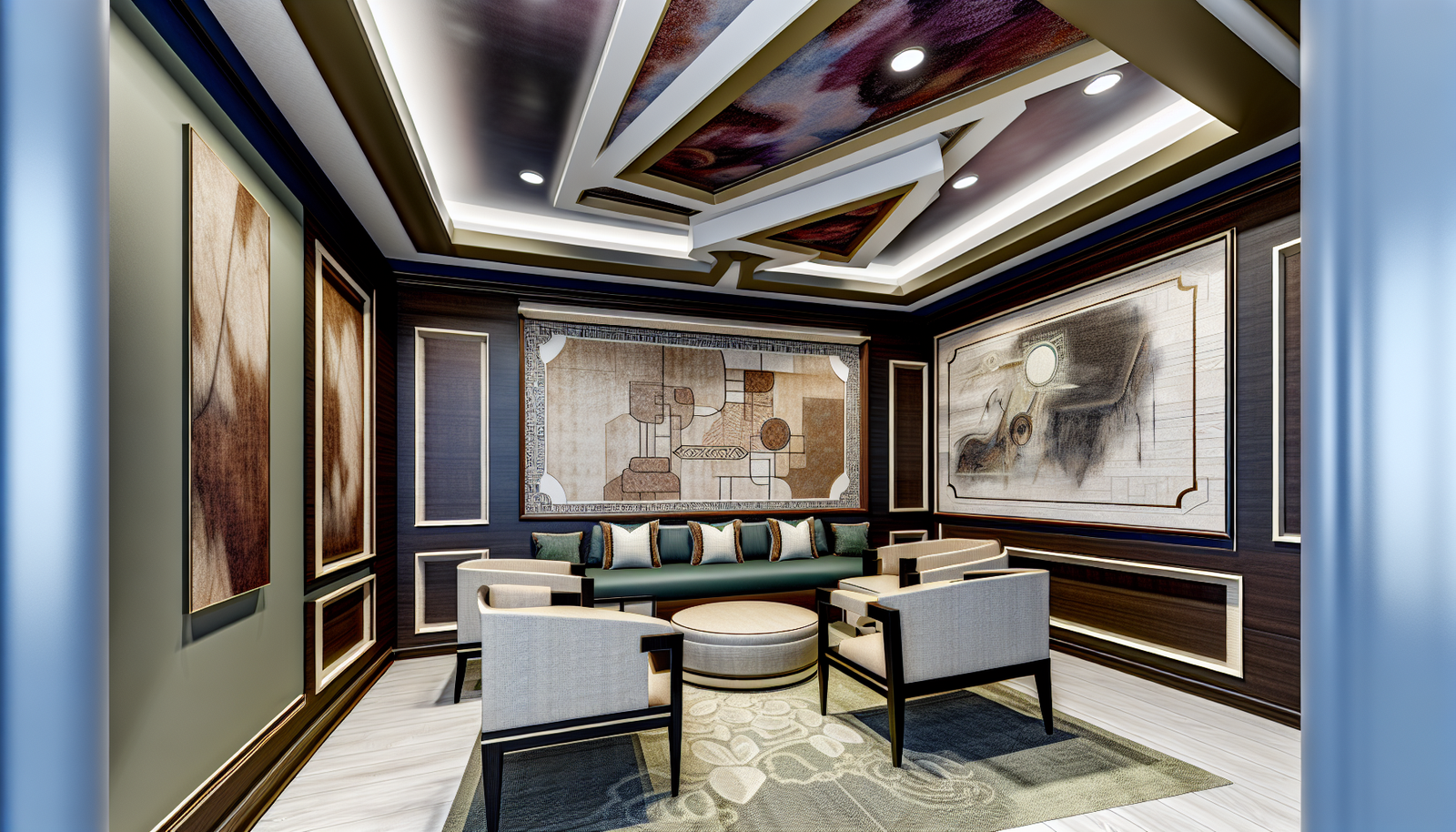
Alright, let’s talk about accent walls. You know, those fantastic focal points that can utterly transform a room from “meh” to “marvelous.” For ages, painting one wall a different color was the go-to trick. And hey, nothing wrong with a bold splash of color, right? But what if I told you we could take that concept, crank it up to eleven, and create something truly unforgettable? We’re talking about accent walls with mixed materials, and let me tell you, it’s a game-changer.
Honestly, it’s like giving your room a personality transplant. Instead of just a visual break, you’re introducing a tactile experience, a story told through wood, metal, stone, and even fabric. It’s an art form, really, blending different textures and finishes to create a cohesive yet dynamic statement. Ready to explore this exciting world?
Why Go Beyond Paint? The Sheer Magic of Texture
Think about it for a second. When you walk into a room, your eyes are drawn to different elements. A painted accent wall certainly grabs attention, but a wall that mixes rough-hewn wood with sleek metal, or perhaps soft velvet panels with industrial concrete? Now that’s an entirely different level of engagement. Your brain, quite instinctively, processes not just the color, but the texture, the depth, and the very essence of the materials.
This isn’t just about looking good, though that’s a huge part of it. It’s about creating a sensory experience. The subtle play of light across different surfaces can add a dynamic quality that paint alone can’t quite achieve. It adds warmth, character, and a sophisticated layer of design that makes your space feel truly custom and utterly unique. Plus, it just feels more substantial, doesn’t it?
The Power of Contrast: Making Your Materials Sing
The secret sauce to a killer mixed-material accent wall often lies in contrast. You want elements that play off each other, not fight. Think about it like a perfectly balanced meal; you don’t want everything to taste the same. You need sweet, savory, perhaps a little crunch. The same goes for your walls!
For instance, pairing something inherently warm and organic, like reclaimed wood, with a cool, industrial material such as steel or polished concrete, creates an incredible visual dialogue. The wood brings history and comfort, while the metal or concrete adds a modern edge. It’s a beautifully complex look that feels both grounded and forward-thinking.
Another fantastic pairing? The smooth, refined elegance of marble alongside the rustic charm of brick. Or perhaps plush fabric panels interspersed with mirrored sections for a glamorous yet inviting vibe. The possibilities, my friends, are practically endless. It’s all about finding materials that tell a compelling story together.
Getting Started: Your Design Playground Awaits!
So, you’re excited, I can tell. But where do you even begin with planning one of these beauties? It can feel a tad overwhelming, I get it. It’s not like picking a paint swatch from Sherwin-Williams, right? This requires a bit more thought, a little more planning, and maybe even a daring spirit.
First off, identify the wall. Which wall in your room is begging for attention? Usually, it’s the one behind a key piece of furniture – like your bed, your sofa, or the dining table. This wall will naturally draw the eye, making it the perfect candidate for your material masterpiece.
Material Mixology: Crafting the Perfect Blend
Here’s where the fun really begins. Let’s talk about some fantastic material combinations you might consider. And honestly, this is just scratching the surface; your imagination is the only real constraint!
- Wood and Stone: The Organic Duo. You can’t go wrong with these two. Imagine a gorgeous stacked stone paneling meeting a warm, rich wood planking. Perhaps a geometric pattern of various wood tones interspersed with rough stone sections. It creates an earthy, grounded feel, perfect for a cozy living room or a rustic bedroom. It’s like bringing the best of nature indoors, but with a refined touch.
- Metal and Concrete: Industrial Chic. For a more contemporary, urban aesthetic, consider the raw beauty of concrete alongside the sleekness of metal. Think large concrete slabs broken up by thin, vertical strips of brushed aluminum or blackened steel. Or perhaps a wall with exposed concrete finishes and a decorative metal screen overlay. It’s edgy, modern, and oh-so-chic. This really speaks to those who love a minimalist yet impactful design.
- Fabric and Mirrors: Luxurious and Light. Want to add some serious glam and softness? Fabric panels, especially velvet, linen, or even acoustic felt, can bring incredible warmth and sound dampening. Pair them with strategically placed mirror sections – antique mirrors for a vintage feel, or clean, frameless ones for modern elegance. This combo can make a room feel larger, brighter, and incredibly sophisticated. It’s like a soft embrace with a touch of sparkle.
- Brick and Plaster: Old-World Charm Meets Modernity. Exposed brick walls have an undeniable appeal, don’t they? But sometimes, a full brick wall can be a bit much. Consider combining natural brick with textured plaster. Maybe half the wall is brick, and the other half is a smooth or subtly textured lime wash plaster. You get that beautiful aged character without overwhelming the space. It tells a story of heritage and evolution.
- Tile and Wood: Pattern Play. Tile isn’t just for bathrooms, my friends! Decorative tiles, especially those with interesting patterns or textures, can be incredibly impactful on an accent wall. Imagine a section of Moroccan cement tiles next to a series of blonde wood slats. Or perhaps small, intricate mosaic tiles contrasting with larger wooden geometric shapes. The interplay of pattern and organic material is captivating.
When you’re trying to figure out which materials to combine, think about the overall vibe you’re aiming for in the room. Are you going for serene and calm? Bold and energetic? Or perhaps a sophisticated blend of both?
The Nitty-Gritty: Technical Considerations and Practical Tips
Okay, so we’ve dreamed up some gorgeous combinations. Now, let’s get down to brass tacks. Because, let’s be honest, transforming your wall isn’t always as simple as slapping on some wallpaper. There are some practicalities to keep in mind, and trust me, ignoring them can lead to headaches later.
One common pitfall, believe it or not, is not properly prepping the existing wall. Whether it’s paint, drywall, or something else, you need a clean, stable surface. For instance, if you’re putting up heavy materials like stone veneers, you might need to reinforce the wall structure. It’s not always just cosmetic; sometimes it’s structural, you know?
Installation Insights: A Peek Behind the Panels
Installing mixed materials can be a bit of a dance. Different materials require different attachment methods. Wood panels might be nailed or glued, while stone veneers often use mortar or specialized adhesives. Metal sheets might be screwed in or mounted with standoffs for a floating effect.
Here’s a practical tip: always, always, always get samples! Seriously. Order a piece of that reclaimed wood, a swatch of that velvet, a square of that tile. See how they look together in your room, under your lighting conditions. What looks great online or in a showroom might behave completely differently in your home. It’s like test-driving a car; you wouldn’t buy it without a spin, right?
Speaking of professional help, for anything beyond basic wood paneling or peel-and-stick applications, consider consulting or hiring a professional. A skilled carpenter, a tiler, or even a specialized installer who understands material properties can save you a world of grief and ensure a flawless finish. They have the right tools and the expertise to handle unique installation challenges, especially when working with different thicknesses or weights.
“Design is not just what it looks like and feels like. Design is how it works.” – Steve Jobs. This quote couldn’t be more true when thinking about the functionality and longevity of your accent wall.
Lighting: The Unsung Hero of Textured Walls
You know what really makes an accent wall sing? Good lighting. Seriously, it’s like a spotlight on your masterpiece. Without proper lighting, all that incredible texture and dimension can get lost in the shadows. It’s a subtle thing, but it makes a colossal difference.
Uplighting or downlighting can dramatically enhance the three-dimensional quality of your mixed materials. Imagine a light grazing across a textured stone surface, highlighting every ridge and valley. Or a gentle wash of light that makes metallic elements gleam softly. Track lighting, wall sconces, or even strategically placed floor lamps can be your best friends here. Don’t underestimate its power!
Maintenance Musings: Keeping Your Masterpiece Pristine
Once your amazing accent wall is up, you’ll want to keep it looking fabulous, right? Maintenance varies greatly depending on your materials. Wood might need occasional cleaning with a damp cloth and perhaps a re-seal every few years. Stone can usually be wiped down, but porous stones might benefit from periodic sealing to repel stains.
Metal surfaces generally require simple dusting or wiping. Fabric panels, well, those might be a bit trickier. Regular vacuuming with an upholstery attachment can help, and for spills, follow the manufacturer’s specific cleaning instructions. Always, always do a patch test in an inconspicuous area before using any cleaning solution on your wall materials.
Style Stories: Where Mixed Materials Truly Shine
This isn’t just about combining materials; it’s about setting a mood, expressing a style. Let’s brainstorm some real-world examples and how these walls can truly anchor a room’s aesthetic.
For a truly Mid-Century Modern vibe, consider a section of warm walnut wood paneling meeting a neutral, perhaps linen-textured wallpaper. Add a sleek, minimalist brass accent, and you’ve got a sophisticated, timeless look. It whispers elegance, it doesn’t shout.
If Bohemian Eclectic is more your jam, how about a mix of raw concrete and macrame wall hangings? Or perhaps reclaimed wood panels interspersed with vibrant, patterned textiles? It’s all about creating a layered, collected, and wonderfully unconventional feel. You get that free-spirited, artsy vibe without things looking messy.
For a refined Contemporary Farmhouse look, think shiplap or beadboard painted a crisp white, contrasted with a smaller section of natural, grey-washed barn wood. Throw in some matte black metal hooks or a simple metal art piece, and you’ve seamlessly blended rustic charm with modern clean lines. This style just feels so inviting, doesn’t it?
And for those who love a bit of Glamorous Hollywood Regency, imagine large, mirrored panels alternating with plush, tufted velvet sections. Maybe even a touch of polished chrome or gold accents woven in. This screams luxury and drama, in the best possible way. It’s like stepping onto a movie set, but in your own home.
The beauty of this trend is its adaptability. It doesn’t pigeonhole you into one aesthetic. It simply provides a canvas for you to tell your unique style story.
A Few More Thoughts on Making it Yours
Honestly, the best designs come from a place of personal connection. Don’t just follow trends blindly. Think about what materials resonate with you. Do you love the warmth of wood because it reminds you of forest walks? Or the coolness of stone because it evokes ancient castles? Your home should be a reflection of who you are, after all.
Another thing to ponder: functionality. Could your accent wall serve a dual purpose? Maybe a mixed-material wall that incorporates shelving units or a built-in bench? Or perhaps a section that hides storage? Combining aesthetics with utility is always a smart move. It’s about being clever with your space, not just pretty.
And don’t forget the rest of the room! Your mixed-material accent wall will be a showstopper, yes, but it needs friends. Ensure your furniture, textiles, and other decor elements complement the wall without competing with it. Let it be the star, and allow everything else to be its graceful supporting cast. You want harmony, not a chaotic jumble.
So, are you ready to ditch the single-color accent wall and embrace the rich, rewarding world of mixed materials? I genuinely hope so! It’s an opportunity to truly elevate your space, infuse it with character, and create a focal point that will have everyone talking (and probably asking for your interior decorator’s number!). Go on, be brave, and let your walls tell a more textured, compelling story!
Feeling inspired? Check out some incredible examples on Houzz or find interesting material suppliers like The Tile Shop to spark even more ideas!
Frequently Asked Questions About Mixed Material Accent Walls
Disclaimer
The information provided in this article is for general guidance and informational purposes only, and does not constitute professional advice. While we strive to provide accurate and up-to-date content, home improvement projects, especially those involving structural changes or heavy materials, can be complex and potentially dangerous if not executed correctly. We strongly advise readers to consult with qualified professionals, such as experienced contractors, interior designers, or structural engineers, before undertaking any significant home renovation. The safety guidelines, material recommendations, and design suggestions shared here are not exhaustive and may not be suitable for all situations or property types. Always prioritize safety, adhere to local building codes, and ensure proper planning and execution for any project.
Categories
- Accent Walls & Ceilings (61)
- Art Curation & Gallery (62)
- Bedding Style Trends (68)
- Bedroom Makeover (81)
- Bohemian & Eclectic Styles (58)
- DIY & Budget-Friendly Decor (64)
- Eco-Friendly Design (62)
- Furniture Care (71)
- Home Decor & Design Ideas (162)
- Home Wellness Spaces (59)
- Integrated Outdoor Living (67)
- Japandi Style (61)
- Kids and Nursery Decor (59)
- Living Room Decor (79)
- Mix & Match Techniques (73)
- Modern & Contemporary Design (66)
- Rug Sizing & Placement (73)
- Scandinavian Design Inspiration (22)
- Seasonal Home Decor (79)
- Small Space Solutions (73)
- Wall Art & Painting Tips (77)
Recent Comments
Archives
Product Gallery
-
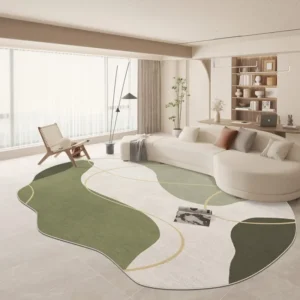 Large Area Green Rugs for Bedroom Nordic Living Room Decoration Shaped Carpet Irregular Plush Lounge Rug Home Thick Washable Mat
Rated 5.00 out of 5$55.01 – $346.86Price range: $55.01 through $346.86
Large Area Green Rugs for Bedroom Nordic Living Room Decoration Shaped Carpet Irregular Plush Lounge Rug Home Thick Washable Mat
Rated 5.00 out of 5$55.01 – $346.86Price range: $55.01 through $346.86 -
 Nordic Style Rugs for Bedroom Morandi Living Room Decoration Carpet Large Area Geometry Lounge Rug Home Cloakroom Non-slip Mat
Rated 5.00 out of 5$39.51 – $598.43Price range: $39.51 through $598.43
Nordic Style Rugs for Bedroom Morandi Living Room Decoration Carpet Large Area Geometry Lounge Rug Home Cloakroom Non-slip Mat
Rated 5.00 out of 5$39.51 – $598.43Price range: $39.51 through $598.43 -
 Irregular Shapes Living Room Decoration Carpet Modern Style Rugs for Bedroom Home Thicken Plush Rug Fluffy Soft Lounge Floor Mat
Rated 4.83 out of 5$55.91 – $347.82Price range: $55.91 through $347.82
Irregular Shapes Living Room Decoration Carpet Modern Style Rugs for Bedroom Home Thicken Plush Rug Fluffy Soft Lounge Floor Mat
Rated 4.83 out of 5$55.91 – $347.82Price range: $55.91 through $347.82

